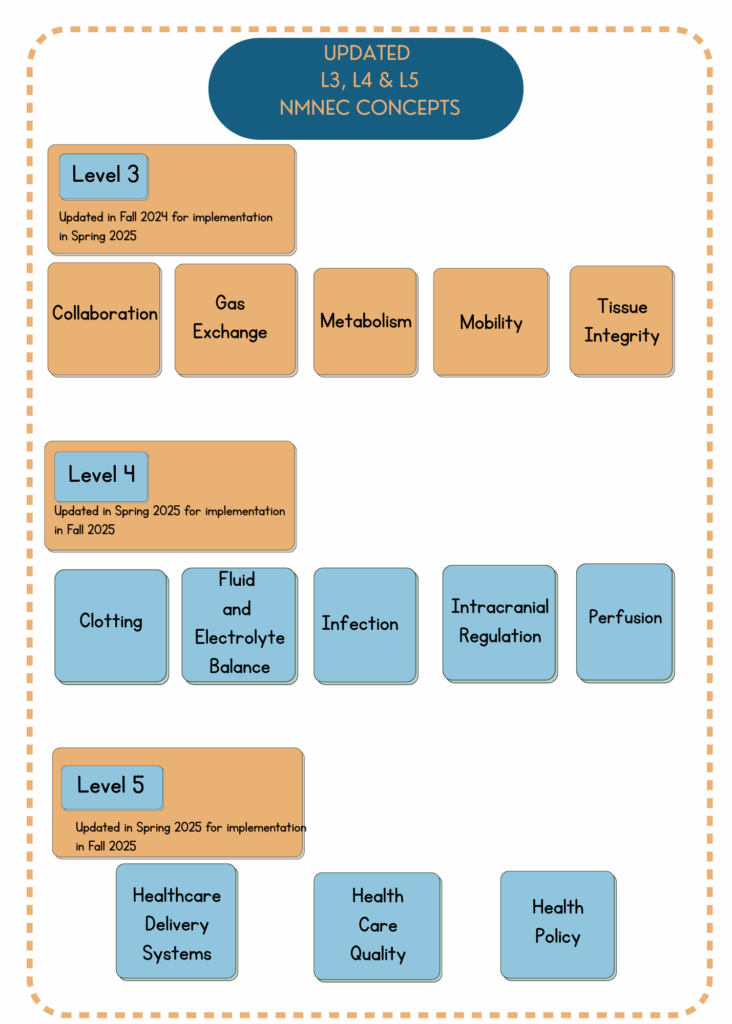
Above is listing of all concepts updated and peer-reviewed by the NMNEC Curriculum Committee and approved by the NMNEC Leadership Council in the 2024-2025 academic year. Key updates are summarized in the table below.
Note: The L4 & L5 concepts updated for Fall 2025 Implementation, have a Patient-Centered Care and Social Determinants of Health (SDOH) Considerations section added. Moving forward, as concepts come up for updating and peer review, the NMNEC Curriculum Committee plans to replace the Diversity, Equity, and Inclusion Considerations section by the Patient-Centered Care and Social Determinants of Health (SDOH) Considerations section.
| L3 Concepts Updated in Fall 2025 and implemented in Spring 2025 | Listed below are edits/changes that were made in addition to adding a ‘Diversity, Equity, and Inclusion Considerations’ section, as well as updating of citations & references: |
| Collaboration | Removed mention of a program that is no longer in existence. |
| Gas Exchange | Mention of Social Determinants of Health (SDOH) added to risk factors. Required Medications with Concept added to concept. |
| Metabolism | Required Medications with Concept added to concept. |
| Mobility | Moved Parkinson’s Disease (PD) from Optional Exemplars to Required Exemplars to bring concept document in alignment with update already made and approved in 2022-2023 and listed in current curriculum documents. Required Medications with Concept added to concept. |
| Tissue Integrity | Updated exemplar terminology from ‘pressure ulcer’ to ‘pressure injury’. Model case removed. |
| L4 Concepts Updated in Spring 2025 and implemented in Fall 2025 | Listed below are edits/changes that were made in addition to adding a ‘Patient-Centered Care and Social Determinants of Health (SDOH) Considerations’ section, as well as updating of citations & references: |
| Clotting | Model case removed. Required Medications with Concept added. Cryoprecipitate added to the ‘Required Medications Table for the Clotting Concept’ per feedback at 2024 NMNEC Statewide Faculty Meeting. |
| Fluid and Electrolyte Balance | Model case removed. Required Medications with Concept added. Statistics updated. |
| Infection | Required Medications with Concept added. Piperacillin and tazobactam (Zosyn) added to the ‘Required Medications Table for the Infection Concept’ per feedback at 2024 NMNEC Statewide Faculty Meeting. Exemplar changes: * Body-Specific Infections changed to Sepsis in Required Exemplars * Suggested options listed under Required Exemplars moved to Optional Exemplars section. * Healthcare-Associated Infections (HAIs) was moved from Optional Exemplars to Required Exemplars |
| Intracranial Regulation | Language change from ‘tobacco usage’ to ‘nicotine usage’ recommended by committee and accepted. Model case removed. Statistics updated. Required medications with Concept added. |
| Perfusion | Model case removed. Required medications with Concept added. Exemplar changes: * Based on feedback from NMNEC faculty course reports, moved of ‘dysrhythmias’ from optional exemplar to required exemplar. * Added hypertensive crisis as an optional exemplar. Statistics updated. Note: Removal of hypertension as an exemplar from the Perfusion concept and addition of hypertension as an exemplar for a Level 3 concept was proposed. NMNEC Curriculum Committee, after soliciting feedback, decided that hypertension will remain as an exemplar with Perfusion concept as it fits best with that concept. Committee made plan to look at possibility of introducing the Perfusion concept, along with Fluid and Electrolyte Balance and Gas Exchange concepts earlier in the semester (Level 2?) and then thread exemplars for these concepts through Levels 2, 3, & 4 with next vertical review of the curriculum (review of placement of concepts & exemplars), possibly starting as soon as the 2025-2026 academic year. |
| L4 Concepts Updated in Spring 2025 and implemented in Fall 2025 | Listed below are edits/changes that were made in addition to adding a ‘Patient-Centered Care and Social Determinants of Health (SDOH) Considerations’ section, as well as updating of citations & references: |
| Healthcare Delivery Systems | Concept definition changed: *Previous definition: Structured systems involved in the delivery of health care services. *New definition: A dynamic, interactive, and structured networks of organizations consisting of people, institutions, and resources working together to deliver health care. Required exemplars changed: *Previous required exemplars: *Local Health Care Delivery Agencies/Systems *Comparative International Health Care systems *Care models developing under Patient Protection and Affordable Care Act (PPACA) *Private vs. Public vs. Specialized Mission (i.e., Veterans Administration [VA] Indian Health Service [HIS]) *New Exemplars: *Local healthcare delivery agencies/systems (public, private, urban, rural, specialized, regional/national) *Clinics and ambulatory care facilities (include day surgery, urgent care, federally qualified health center [FQHC]) *Nursing homes (independent, assisted, skilled, long-term and memory care) *Specialized Mission (i.e., Veterans Administration [VA] Indian Health Service [IHS]) |
| Health Care Quality | New concept definition approved as being more comprehensive: “Health care quality refers to the degree to which health services for individuals and populations increase the likelihood of desired health outcomes and are consistent with current professional knowledge, evidence-based practice, patient safety principles, and equitable, person-centered care (Harris-Wehling, 1990).” Theoretical Link section updated. Knowledge, Skills, and Attitudes (KSAs) section updated. Interrelated Concepts list updated. |
| Health Policy | Concept definition changed: *Previous definition: Decisions by governmental bodies, and private organizations, or society aimed at directing and influencing actions and decisions of organizations and individuals in the health care system. *New definition: “Goal-directed decision making about health that is the result of an authorized, public decision-making process. Health policy is further defined as those actions, nonactions, directions, and/or guidance related to health that are decided by governments or other authorized entities” (Marfell, et al., 2025, p. 612). Non-governmental participation in health policy information added. Required exemplars updated: *‘Regulatory Agencies’ changed to ‘Agencies that set policy’. *Healthy People 2020 updated to Healthy People 2030. |

Recent Comments